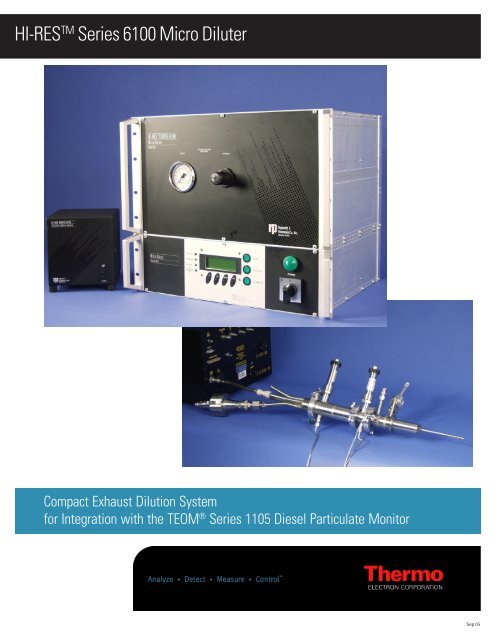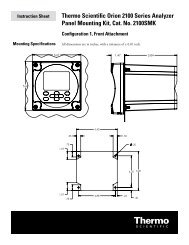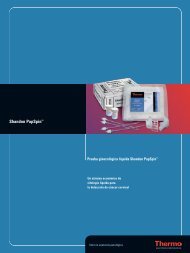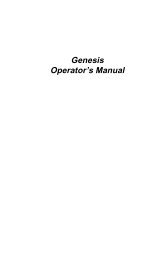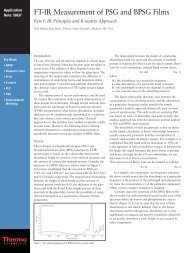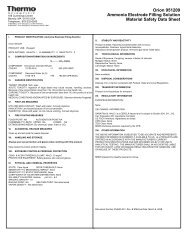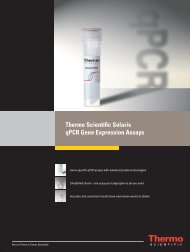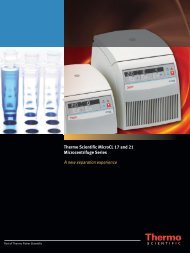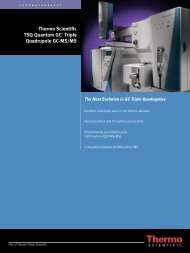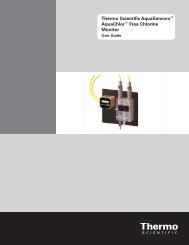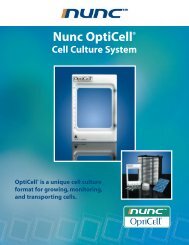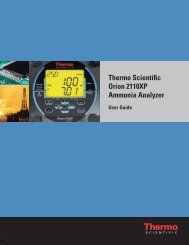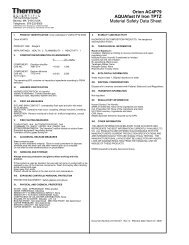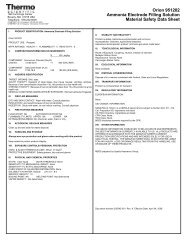HI-RESTM Series 6100 Micro Diluter
HI-RESTM Series 6100 Micro Diluter
HI-RESTM Series 6100 Micro Diluter
You also want an ePaper? Increase the reach of your titles
YUMPU automatically turns print PDFs into web optimized ePapers that Google loves.
<strong>HI</strong>-RES TM <strong>Series</strong> <strong>6100</strong> <strong>Micro</strong> <strong>Diluter</strong><br />
Compact Exhaust Dilution System<br />
for Integration with the TEOM ® <strong>Series</strong> 1105 Diesel Particulate Monitor<br />
Sep 05
Capabilities<br />
The High-performance Integrated Raw Exhaust Sampler (<strong>HI</strong>-RES TM unit) is designed<br />
to complement the TEOM ® <strong>Series</strong> 1105 Diesel Particulate Monitor to provide a<br />
definitive approach for sampling and quantifying exhaust particulate matter. The<br />
compact device offers a convenient means of sampling and diluting hot and moist<br />
exhaust streams containing particles. The operation of the dilution tunnel is<br />
automatically controlled through the operating software of the TEOM monitor.<br />
Dilution of the sample stream takes place in two stages to allow users to sample<br />
from high temperature, high pressure sources without transmitting those thermodynamic<br />
conditions to downstream particle measurement and sampling devices.<br />
Users can configure the dilution system in different ways to attain the desired<br />
dilution ratio, temperatures and residence time.<br />
Other devices in addition to the TEOM monitor, such as filter holders or particle<br />
counting devices, can simultaneously sample the diluted exhaust stream from the<br />
<strong>HI</strong>-RES System. The TEOM monitor provides gravimetric-equivalent, filter-based<br />
mass concentration readings in real time, while other approaches can provide<br />
additional information concerning the particles emitted by a source.<br />
Rack-Mountable Components of <strong>HI</strong>-RES System<br />
Combined with TEOM <strong>Series</strong> 1105 Monitor.<br />
Applications<br />
Users can deploy the <strong>HI</strong>-RES unit for a variety of particle-related measurements<br />
of mobile and stationary sources. These include the following:<br />
Mobile sources...<br />
• Sampling of particulate matter from before and after catalyst or diesel<br />
particulate filter treatment devices to determine particle removal efficiencies.<br />
• Emissions calibrations for engine mapping and component evaluations.<br />
• Emission test cycles.<br />
• Fuel and lubricant studies.<br />
Stationary sources...<br />
• USEPA Method 5 condensables measurements.<br />
• PM-10 and PM-2.5 USEPA test methods similar to 201A.<br />
• USEPA conditional test method CTM 039 for PM-2.5 stationary sources.
System Configuration<br />
The <strong>HI</strong>-RES System builds upon the TEOM <strong>Series</strong> 1105 Diesel Particulate Monitor, and<br />
integrates into the data handling and user interfaces of the mass monitoring device. In<br />
addition to the dilution tunnel, the <strong>HI</strong>-RES device is composed of a control unit, valve<br />
unit, and pressure control module (front cover). The control and valve units are rack<br />
mountable, and have their electric and pneumatic connections on their back panels.<br />
The dilution system samples raw exhaust through a multi-hole probe (see photo) that is<br />
directly connected to the dilution tunnel, where the first-stage radial inflow diluter is<br />
followed by an ejection diluter. A flow splitter downstream of the ejector diluter provides<br />
up to 150 l/min of diluted air through multiple outlets (see photos).<br />
The control unit monitors temperatures and pressures, and contains a menu-driven user<br />
interface for calibrating and controlling the dilution valves.<br />
The valve unit houses the valves that control the dilution air supplies to the first- and<br />
second-stage diluters, as well as the cooling air or water supply for the first-stage jacket.<br />
The pressure control module is located between the external dilution air supply and valve<br />
unit, and acts upon the incoming dilution air stream to maintain the proper pressure<br />
conditions for the <strong>HI</strong>-RES System.<br />
Detail of Exit Ports on Flow Splitter.<br />
<strong>HI</strong>-RES System, with Probe at Left and<br />
Exit Flow Splitter at Right.<br />
<strong>HI</strong>-RES Dilution System Attached to TEOM Monitor<br />
and Filter Holder, with Residence Chamber Installed<br />
(Top) and Without Residence Chamber (Left).<br />
Multi-Hole Probe of <strong>HI</strong>-RES System<br />
Inserted into Raw Exhaust Channel.<br />
Main Sample, Dilution and Cooling<br />
flows in the <strong>HI</strong>-RES System.<br />
Advanced Dilution Technology<br />
Sample stream dilution takes place in two stages to maximize the conditioning<br />
effect and consistency of the diluted sample stream. To lengthen<br />
the mixing duration, a residence chamber (see photo) can be installed<br />
between the second-stage injection diluter and flow splitter, or between<br />
the first and second dilution stages.<br />
The dilution ratio set points of the primary and secondary dilution stages<br />
are independently selectable by the user.<br />
The first dilution stage employs a radial inflow design, a well accepted<br />
dilution geometry whose performance has been validated in aerosol<br />
studies. The stage is jacketed, permitting the use of a cooled air or<br />
chilled water stream to reduce the sample temperature in high temperature<br />
applications.<br />
The second dilution stage is an ejector diluter, in which pressurized air<br />
acts as a pump and returns the sample to ambient pressure.
User Interface<br />
The operating software for the <strong>HI</strong>-RES System is incorporated in<br />
the Windows-based operating program of the TEOM <strong>Series</strong> 1105<br />
Diesel Particulate Monitor. This provides seamless operating,<br />
control and data storage capability for both the dilution unit and<br />
TEOM monitor. A dedicated window within the program contains<br />
the calibration, set points, alarms, and control functions of the<br />
<strong>HI</strong>-RES dilution unit.<br />
The user selects the desired dilution ratio through the software<br />
interface. In response, the system automatically determines the<br />
appropriate valve and dilution air flow settings to achieve the<br />
target dilution ratio.<br />
Integrated with the TEOM monitor, the system provides full TCP/<br />
IP control of major functions and data reporting. Start, stop,<br />
flush, and other functions can be controlled remotely through a<br />
test cell network. Remote computers connected to the network<br />
can also record total mass, mass concentration and mass rate<br />
information, corrected and uncorrected for the dilution ratio.<br />
The software contains calibration wizards for conducting audits<br />
of the system temperatures, flows and dilution ratios. The user<br />
can set alarm thresholds for temperatures and pressures, and for<br />
indicators that the system requires routine maintenance.<br />
Back Panel Electrical and Pneumatic Connectors on the Control and Valve<br />
Units.<br />
TEOM/<strong>HI</strong>-RES Software with Options Window for<br />
Dilution Tunnel Operating Parameters.<br />
Main Screen of TEOM/<strong>HI</strong>-RES Windows-Based<br />
Control Software.<br />
Environmental Instruments Division 26 Tech Valley Drive, East Greenbush, NY 12061, USA<br />
Air Quality Instruments Phone (518)452-0065 • Fax (518)452-0067<br />
rp Products<br />
www.thermo.com/air<br />
TEOM is a registered trademark of Thermo Electron Corporation.<br />
<strong>HI</strong>-RES is a trademark of Thermo.


